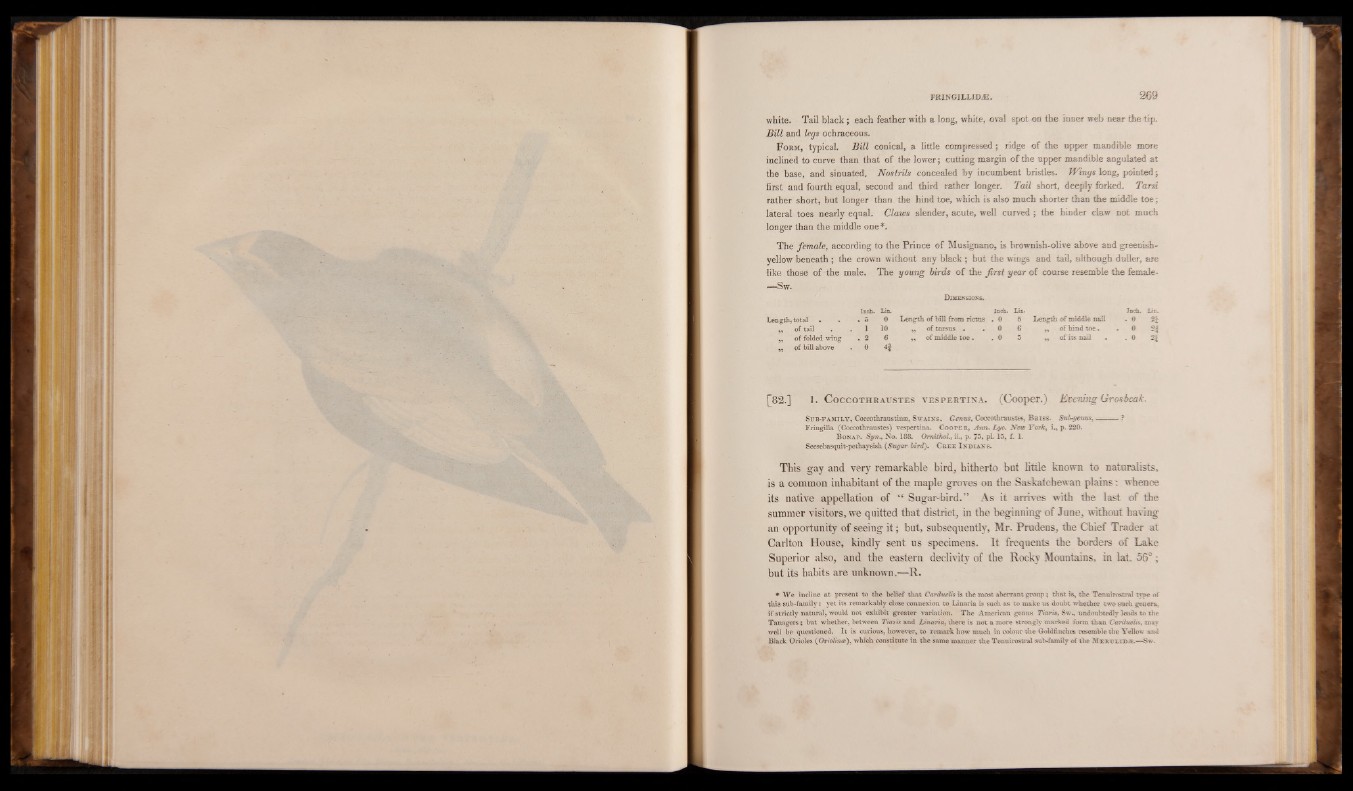
white. Tail black; each feather with a long, white, oval spot on the inner web near the tip.
Bill and legs ochraceous.
F orm, typical. Bill conical, a little compressed; ridge of the upper mandible more
inclined to curve than that of the lower; cutting margin of the upper mandible angulated at
the base, and sinuated. Nostrils concealed by incumbent bristles. Wings long, pointed;
first and fourth equal, second and third rather longer. Tail short, deeply forked. Tarsi
rather short, but longer than the hind toe, which is also much shorter than the middle toe;
lateral toes nearly equal. Claws slender, acute, well curved ; the hinder claw not much
longer than the middle one *.
The female, according to the Prince of Musignano, is brownish-olive above and greenish-
yellow beneath; the crown without any black; but the wings and tail, although duller, are
like those of the male. The young birds of the first year of course resemble the female.
■—Sw.
Dimensions.
Length, total • .
'Inch.
0
,, of tail . 1 10
„ of folded wing . 2 6
,, of bill above 0 4f
Inch. Lin.
Length of bill from rictus . 0 5
,, of tarsus • . 0 6
„ of middle toe. . 0 5
Inch. Lin.
Length of middle nail . 0
„ of hind toe. . 0 2f
,, of its nail . . 0 2|
[8 2 .] 1. C o c c o t h r a u s t e s v e s p e r t in a . (Cooper.) Evening Grosbeak.
Sub-f a m il y , Coccothraustin», Sw a in s. Genus, Coccothraustes, B r is s . Sub-genus,---------?
Fringilla (Coccothraustes) vespertina. Co o pe r , Ann. Lye. New York, i., p. 220.
B onap. Syn., No. 188. Ornithol., ii., p. 75, pi. 15, f. 1.
Seesebasquit-pethaysish (Sugar bird). Cr e e I n d ia n s .
This gay and very remarkable bird, hitherto but little known to naturalists,
is a common inhabitant of the maple groves on the Saskatchewan plains: whence
its native appellation of “ Sugar-bird.” As it arrives with the last of the
summer visitors, we quitted that district, in the beginning of June, without having
an opportunity of seeing it; but, subsequently, Mr. Prudens, the Chief Trader at
Carlton House, kindly sent us specimens. It frequents the borders of Lake
Superior also, and the eastern declivity of the Rocky Mountains, in lat. 56°;
but its habits are unknown.—R.
* We incline at present to the belief that Carduelis is the most aberrant group; that is, the Tenuirostral type of
this sub-family: yet its remarkably dose connexion to Linaria is such as to make us doubt whether two such genera,
if strictly natural, would not exhibit greater variation. The American genus Tiaris, Sw., undoubtedly leads to the
Tanagers; but whether, between Tiai is and Linaria, there is not a more strongly marked form than Carduelis, may
well be questioned. It is curious, however, to remark how much in colour the Goldfinches resemble the Yellow and
Black Orioles (Oriolinas), which constitute in the same manner the Tenuirostral sub-family of the Me r u l id je .—Sw.